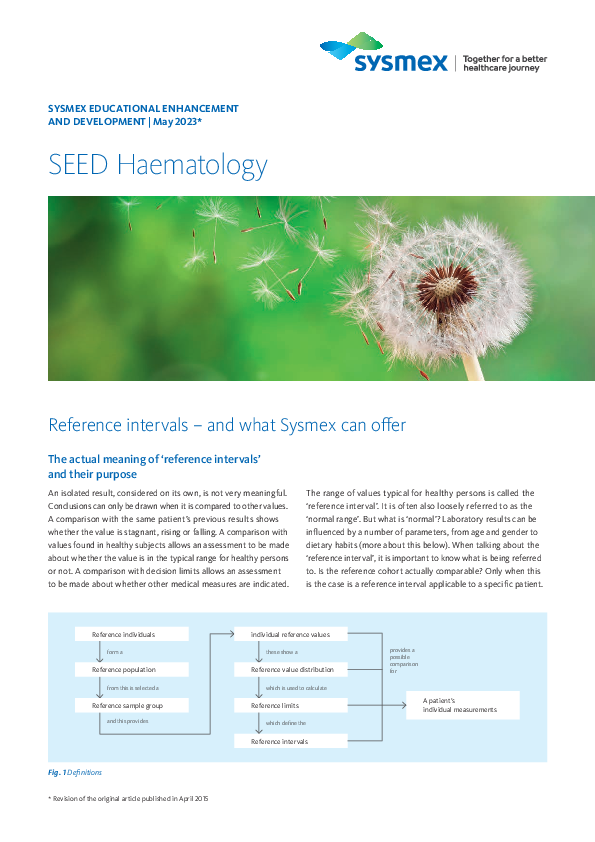-
Empresa
-
Nuestros productos
-
Servicios
-
Academia
Reference intervals – and what Sysmex can offer
For any clinical laboratory analysis, reliable and accurate reference intervals are essential to correctly interpret the test results. Accordingly, Sysmex is very frequently asked about reference intervals for haematology parameters.
While we are glad to provide you with a selection of literature, we would like to point out that reference intervals from different studies are only conditionally transferable, depending on the age, gender, ethnicity, etc. of the patient population in question. For this reason, the individuals who served as the basis for the selected reference interval should be as similar as possible to the patient population to whom the reference interval is to be applied.
Currently, there are several scientific publications available that provide information about reference intervals for Sysmex analysers. These studies were performed on a variety of Sysmex haematology analyser models and the reference intervals evidently differ according to the populations involved. This also means that published reference intervals from older analyser models have to be validated before they may be used with newer ones. Since – as explained above – there are differences between haematological reference intervals determined from different populations, the information in the table below may facilitate the selection of an appropriate reference interval as an initial point for validation.
Examples of reference intervals for Sysmex analysers
First author | Citation | Analyser | Parameters | Population |
| Mrosewski I et al. | Clin Chem Lab Med | XN-9000 | CBC | German, paediatric |
| van Pelt JL et al | Clin Chem Lab Med | XN-Series | CBC+DIFF+RET+PLT-F | Dutch |
| Int J Lab Hematol | XN-Series | CBC+DIFF+RET | Belgium, adult | |
| Wilson S et al. | Int J Lab Hematol | XN-3000 | CBC+DIFF | Canadian, paediatric |
| Int J Lab Hematol | XN-3000 | CBC+DIFF | Canadian, paediatric | |
| Arch Pathol Lab Med | XN-1000 | CBC+DIFF+RET+PLT-F | US American, newborns | |
| Arbiol-Roca A et al. | EJIFCC | XN-Series | CBC+DIFF+RET | Spanish |
Validation of reference intervals
Adopting a published reference interval without validation is not permissible and can even be dangerous for patients. Its suitability as a reference must be examined in every case. To do this, the International Federation of Clinical Chemistry (IFCC) suggests the following procedure [1]:
Twenty local reference samples are taken and compared with the reference interval published elsewhere. If not more than two of the 20 samples are outside this interval, it may be used. If three to four samples are outside the reference interval, a further 20 new samples must be taken and measured. If not more than two of these 20 samples are outside the interval, it may be used. If in the initial verification five or more samples or more than two of a repeated set of samples are outside the published interval, it is not suitable for use as a reference for local patients. A new survey or the validation of another, different reference interval would be the next options.
[1] Solberg HE et al. (2004): The IFCC recommendation on estimation of reference intervals. The RefVal program. Clin Chem Lab Med 42: 710–714.
A new indirect approach of determining reference intervals
The International Federation of Clinical Chemistry (IFCC) Committee on Reference Intervals and Decision Limits (C-RIDL) recently published an opinion paper about ‘indirect’ methods for reference interval determination [2]. The ‘indirect’ approach to determine reference intervals refers to a statistical analysis of already existing results from specimens which were collected for routine purposes (for example, samples collected for screening, diagnostic or monitoring purposes). This novel approach is not only a useful adjunct to the use of traditional direct methods, but also has a number of advantages such as basing the outcomes on the analytical and pre-analytical procedures in use, the ability to address a wide interval of populations, especially the population served by the laboratory, and, importantly, the relative ease of use and far lower costs. In this opinion paper, the IFCC C-RIDL encourages laboratories ‘to use indirect methods to evaluate their reference intervals in use, to estimate new reference intervals and to publish and share their results in appropriate detail and also to continue the search for new and improved techniques for the process’.
[2] Jones GRD et al. (2018): Indirect methods for reference interval determination – review and recommendations. CCLM, 57 (1), 20-29 Free online: https://pubmed.ncbi.nlm.nih.gov/29672266/

Reference intervals are essential for allowing conclusions on patients results. This SEED article explains how reference intervals are defined and how they can be obtained in the lab. The procedure to examine the suitability for reference values that were determined elsewhere is explained as well.